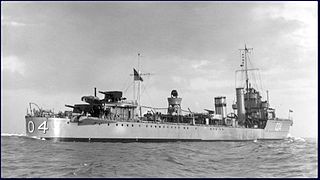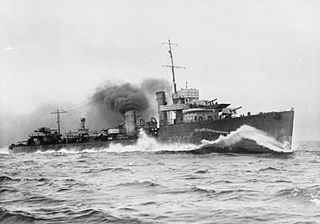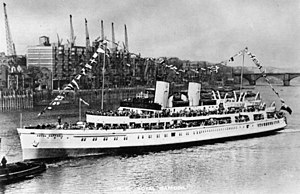
The PS Medway Queen is a paddle driven steamship, the only mobile estuary paddle steamer left in the United Kingdom. She was one of the "little ships of Dunkirk", making a record seven trips and rescuing 7,000 men in the evacuation of Dunkirk.

HMS Whitshed (D77/I77) was an Admiralty modified W-class destroyer of the Royal Navy. She was ordered from Swan Hunter & Wigham Richardson Ltd under the 14th Order for Destroyers in the Emergency War Program of 1918–19. She was the first ship to carry the name.

HMS Keith was a B-class destroyer flotilla leader built for the Royal Navy around 1930. Initially assigned to the Mediterranean Fleet, she was placed in reserve in 1937, after repairs from a collision were completed. During the Spanish Civil War of 1936–1939, the ship was reactivated and spent some time in Spanish waters, enforcing the arms blockade imposed by Britain and France on both sides of the conflict. Keith escorted convoys and conducted anti-submarine patrols early in World War II before being sunk at Dunkirk by German aircraft.

HMS Kingfisher (L70) was a Royal Navy patrol vessel and the lead ship of the Kingfisher-class sloops, laid down in 1934 and commissioned in 1935. She took part in the Dunkirk evacuation, and spent much of the Second World War as an experimental trials ship. She was sold for scrap in 1947.

HMS Atherstone was a Racecourse-class minesweeper of the Royal Navy. The Racecourse class comprised 32 paddlewheel coastal minesweeping sloops.

HMS Albury was a Hunt-class minesweeper of the Aberdare sub-class built for the Royal Navy during World War I. She was not finished in time to participate in the First World War and survived the Second World War to be sold for scrap in 1947.

HMS Winchelsea (D46) was an Admiralty W-class destroyer of the Royal Navy, ordered 9 December 1916 from J. Samuel White at Cowes during the 1916–17 Build Programme.

SS Royal Daffodil was a Mersey ferry, built in 1906 and scrapped in 1938. She was built as Daffodil but renamed Royal Daffodil in recognition of her service under requisition during the 1st World War.
The Little Ships of Dunkirk were about 850 private boats that sailed from Ramsgate in England to Dunkirk in northern France between 26 May and 4 June 1940 as part of Operation Dynamo, helping to rescue more than 336,000 British, French, and other Allied soldiers who were trapped on the beaches at Dunkirk during the Second World War.

HMS Westminster was a W-class destroyer of the Royal Navy. She was the first ship to bear the name. Launched in 1918, she served through two World Wars, and survived both to be sold for scrap in 1947.

HMS Vancouver was a British V-class destroyer. She was launched on 28 December 1917; in July 1922 she accidentally rammed the submarine H24. She was renamed HMS Vimy in April 1928. She served with distinction during World War II, earning two battle honours and damaging or sinking three enemy submarines. The Royal Navy retired her in 1945 and she was scrapped in 1948.

HMS Vimiera was a V-class destroyer ordered as part of the 1917–18 programme.

HMS Wolfhound was one of 21 W-class destroyers built for the Royal Navy during the First World War. Completed in 1918 the ship only played a minor role in the war before its end. The ship was converted into an anti-aircraft escort destroyer during the Second World War and was badly damaged during the Dunkirk evacuation. Wolfhound survived the war and was sold for scrap in 1948.

HMS Shikari (D85) was an Admiralty S-class destroyer of the Royal Navy. She was built by William Doxford & Sons, Sunderland and launched on 14 July 1919. She was one of the destroyers that took part in the Invergordon Mutiny. In 1933, she was briefly commanded by Frederic John Walker, who was to rise to fame as the foremost Allied submarine hunter of World War II.
HMS Melton was a Racecourse-class minesweeper of the Royal Navy. The Racecourse class comprised 32 paddlewheel coastal minesweeping sloops.

HMS Vivacious (D36) was a V-class destroyer of the British Royal Navy that saw service in World War I and World War II.

HMS Venomous (ex-Venom), was a Modified W-class destroyer of the British Royal Navy that saw service in the Russian Civil War and World War II.

HMS Wolsey (D98) was a W-class destroyer of the British Royal Navy that saw service in the final months of World War I, in the Nanking incident of 1927, and in World War II.

PS Duchess of Fife was a paddle steamer built in 1903 for the Caledonian Steam Packet Company. She spent most of her career serving passenger routes in the Firth of Clyde and was requisitioned for use as a minesweeper during both World Wars. In 1940 she took part in the Dunkirk evacuation, rescuing a total of 1,633 allied troops.

HMS Sharpshooter was a Halcyon-class minesweeper of the British Royal Navy. Built at Devonport Dockyard, Sharpshooter was completed in 1937. She served through the Second World War, acting both in her designed role as minesweeper and as a convoy escort, escorting several Arctic convoys. She took part in the evacuation from Dunkirk in 1940, and sank the German submarine U-655 in 1942.


















